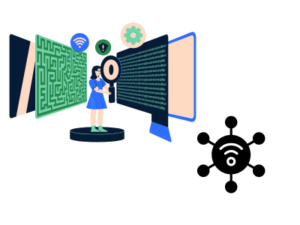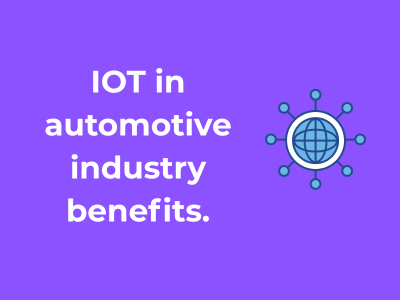What Is IoT in the Context of Automobiles?
At its core, IoT in automobiles involves embedding sensors, software, and connectivity features into vehicles to enable seamless communication between cars, infrastructure, and even other machines. Think of vehicles no longer as isolated entities but as interactive components of a much larger, smarter system. Through IoT, your car can “think” and “communicate,” creating a truly dynamic driving experience.
How Is IoT Transforming Automobiles?
IoT brings some incredibly exciting shifts to the automotive space. Here are just a few areas where we’re seeing this transformation in action:
- Smart Connected Features: Cars are no longer just mechanical marvels; they’re smart machines equipped with voice assistants, Wi-Fi capabilities, and more. Technologies like voice-activated controls don’t just offer convenience; they also improve safety by minimizing distractions.
- Data-Driven Insights: IoT allows cars to collect and analyze data in real time. From fuel efficiency to GPS navigation and even driver behavior patterns, this data is reshaping what’s possible in terms of performance and personalization.
- Seamless Vehicle-to-Infrastructure Communication: Ever wondered how your car can warn you about upcoming traffic or suggest faster routes? IoT facilitates real-time data exchange between vehicles and smart infrastructure, enabling quicker and more informed decisions. Whether it’s avoiding accidents or simply saving time, this connectivity is a game-changer.
Why Your Next Car Could Be a “Smart” One
As IoT becomes more widespread, the idea of the “smart car” is quickly shifting from future speculation to current reality. Having the ability to communicate with gadgets inside and outside the vehicle enhances convenience and safety to levels we could only dream of decades ago. Consider these real-life benefits:
- Enhanced Safety: Sensors powered by IoT can detect blind spots, monitor lane departures, and even provide alerts for objects or pedestrians in proximity. All of these features create a safer experience for both drivers and pedestrians.
- Personalization: Using IoT, modern vehicles learn drivers’ preferences, from seat settings to climate control. The result? Your car feels tailor-made for you every single time you hop in.
- Reduced Driver Fatigue: IoT systems work to reduce physical and mental fatigue by automating repetitive tasks, such as adaptive cruise control and automated parking.
The Takeaway
The role of IoT in transforming automobiles isn’t just about adding bells and whistles. It’s about creating smarter, safer, and more efficient vehicles that are better attuned to our needs. With continuous innovation, the potential for IoT-equipped cars is truly limitless. So, the next time you hop into a car that suggests your favorite song or finds the fastest route home, you’ll know it’s all thanks to the awesome capabilities of IoT!
Understanding the Journey: From Engine to Grid with IoT

When you think about cars and technology, it might be exciting to imagine self-driving cars or fancy GPS systems. But, what if I told you there’s much more happening behind the scenes? Thanks to the Internet of Things (IoT), your car isn’t just a mode of transport anymore – it’s a network of interconnected systems, communicating constantly with each other and even with external networks. Isn’t that fascinating?
What Do We Mean by “From Engine to Grid”?
Think of your car as a mini-ecosystem. The engine, battery, fuel system, sensors, brakes – all of these elements need to work together to ensure that your vehicle runs smoothly. But here’s where IoT steps in to take things to the next level. It doesn’t just connect components within the car; it also connects your car to the outside world, like electric grids, traffic systems, or even your smart home devices. This creates a whole new level of interaction and efficiency.
Imagine your electric vehicle (EV) being able to communicate directly with the power grid. It knows when to charge during off-peak hours for the best electricity rates. Better yet, it can even feed unused power back into the grid. This is what we mean by “engine to grid” – it’s a seamless flow of energy and data across systems, making your car an active participant in a much larger network.
The Tech That Drives Connectivity
How does this all happen? It’s all about integrating smart sensors, wireless connectivity, and advanced software into vehicles. Here are some key components of IoT-enabled automotive systems:
- Embedded Sensors: These tiny but powerful sensors collect real-time data on just about everything – engine temperature, tire pressure, fuel or battery levels, and even air quality inside the cabin.
- Telematics Units: Acting as the communication bridge, telematics units share data between your car and external networks, enabling smoother interaction between systems.
- Cloud Computing: The cloud is where the magic happens. All the data collected from your car and systems is processed and analyzed here to provide actionable insights. Think of it as the brain of the operation!
- Vehicle-to-Everything (V2X) Technology: This buzzword refers to your car’s ability to communicate with other vehicles, traffic lights, pedestrian systems, and more – making roads and interactions safer and more efficient.
Real-World Applications of Grid Connectivity
Let’s make it relatable. Say you’re heading home after work in your electric vehicle. Thanks to IoT, your car knows where to find the fastest charging station with the lowest rates. Meanwhile, it can notify your home’s smart thermostat to adjust the temperature so your house is cozy upon arrival. Cool, right?
For fleet operators or logistics companies, IoT enhances fleet management by syncing vehicles with centralized systems. This ensures optimal fuel or battery usage, predictive routing, and unparalleled efficiency across the operation. Who knew that IoT could make our roads greener?
What’s in It for Drivers?
Practical convenience aside, this connectivity promotes a more sustainable approach to driving. Reducing idle time, optimizing fuel consumption, and leveraging renewable energy sources add up to a smaller carbon footprint. Plus, the integration with power grids means we are paving the way for an era of energy-conscious transportation.
So, next time you’re in your car, take a moment to appreciate how a seemingly simple ride is powered by a complex yet amazing web of IoT connectivity. It’s mind-blowing to think that something as routine as driving could contribute so dynamically to global energy efficiency and sustainability!
Enhancing Driver Experiences: Practical Applications of IoT
Have you ever stepped into a car and felt like it just *knew* you? That’s not magic—it’s the Internet of Things (IoT) at work! IoT is revolutionizing the way we interact with our vehicles, transforming them into intelligent machines that cater to our preferences, ensure our comfort, and make our journeys more enjoyable.
Customizing the Ride
Remember the frustration of adjusting your seat, side mirrors, and temperature every time someone else borrowed your car? IoT solves that hassle with personalized profiles stored in the cloud! Now, as soon as you hop in, your car greets you by automatically setting everything to your preference—whether it’s the seat position or your favorite playlist.
And if you thought that wasn’t convenient enough, IoT can add even more flair by integrating with voice assistants like Alexa or Google Assistant. Simply say, “play my road trip music” or “set the cabin temperature to 72 degrees,” and voilà! Your car is your obedient co-pilot.
Smart Navigation and Route Optimization
Gone are the days of flipping through awkward maps or arguing with outdated GPS systems. With IoT, navigation systems are sharper, more intuitive, and incredibly user-friendly. IoT-enabled cars connect to real-time traffic data, updating routes dynamically to save you time and help avoid frustrating bottlenecks.
Ever run low on gas or parking in an unfamiliar area? IoT has your back. Modern vehicles can guide you to the nearest gas station with competitive prices or locate an available parking spot—yes, no more circling the block endlessly!
Entertainment Like Never Before
Let’s talk about in-car entertainment—an area where IoT is truly shining. Systems today are designed for seamless integration with your smartphone or favorite streaming services. Sync your Spotify, tune into podcasts, or cue up your Netflix (not while driving, of course!) for passengers in the back seat.
What’s even cooler is that these systems can adapt to the preferences of different users. If your kids want cartoons but you’d rather listen to jazz, IoT can deliver tailored content for everyone at the same time on separate screens or speakers.
Ensuring Comfort and Well-being
Driving shouldn’t be exhausting, which is why IoT innovations focus on your comfort. Smart climate control adapts the cabin conditions based not only on your preferences but also external weather patterns, ensuring a cozy environment regardless of outside conditions.
IoT also plays a role in monitoring driver well-being. Imagine your car recognizing signs of fatigue, like irregular lane changes or extended periods without a break, and suggesting a quick rest stop. Some vehicles even offer connected seat vibrations or alerts to keep you awake—how’s that for a caring companion?
Stay Connected, Always
One of IoT’s most practical features is constant connectivity. Forgot to lock your car? Use a smartphone app to secure it remotely. Want to pre-start your car and warm it up on a chilly morning? IoT-enabled remote start has you covered. It’s all about convenience at your fingertips.
What Does This All Mean for You?
The practical applications of IoT in enhancing driver experiences are all about creating a journey that’s smoother, safer, and tailored just for you. It’s not just about getting from point A to point B; it’s about making every trip a personal and enjoyable experience. And as IoT keeps evolving, who knows—your car might just become your favorite travel companion!
So buckle up and enjoy the ride! Technology is taking care of the rest.
Predictive Maintenance: IoT’s Impact on Vehicle Longevity

Let’s face it, no one enjoys the unexpected breakdown of their car. It’s inconvenient, costly, and almost always happens at the worst possible moment. Thankfully, with the rise of IoT (Internet of Things), predictive maintenance has become a game changer in addressing this age-old challenge. Let’s dive into what this means and how it works!
What Is Predictive Maintenance?
Predictive maintenance, put simply, is a proactive way of monitoring your vehicle’s health to prevent issues *before* they cause trouble. Traditional car maintenance often follows a scheduled approach—it’s based on time or mileage, like a “bring your car back in 6 months” rule. But IoT introduces digital intelligence that monitors your car in real time and “predicts” issues based on data gathered from your car’s sensors.
How Does IoT Make This Possible?
IoT allows cars to be equipped with smart sensors that track critical components such as the engine, brakes, tires, and battery. These sensors collect information about performance, wear, and possible anomalies. Here’s where the magic happens: this data is analyzed, often using artificial intelligence or machine learning, to predict when something might break down.
For example, instead of waiting for your battery to suddenly die one frosty morning, your car could send you an alert through a mobile app, telling you to replace it soon because it’s starting to underperform. The result? You stay in control, avoid unpleasant surprises, and extend the life of your vehicle. Pretty cool, right?
Benefits Beyond Convenience
Predictive maintenance isn’t just a convenience feature; it’s a revolution in automotive care. Here’s how it benefits vehicle owners:
- Cost Savings: Catching wear-and-tear early often saves you from more expensive breakdown repairs later.
- Increased Safety: Proactively addressing issues like worn brakes or underinflated tires reduces the likelihood of accidents.
- Extended Vehicle Life: Regular and targeted maintenance helps your car last longer and age more gracefully.
- Environmental Benefits: A well-maintained vehicle runs more efficiently, reducing emissions and fuel consumption.
Examples of IoT in Predictive Maintenance
If you’re wondering whether this is already happening, the answer is a resounding “yes!” Many automakers have embraced IoT-based predictive maintenance. Some examples include:
- BMW: The BMW Connected app offers a feature called “Teleservice” that notifies owners and dealerships if something needs attention, like oil or brake fluid replacement.
- Tesla: Teslas come loaded with sensors and software that enable predictive maintenance, sending software updates and servicing alerts automatically.
- Ford: Ford’s “FordPass” app connects drivers with real-time diagnostics and maintenance reminders.
Tips To Get the Most Out of IoT Predictive Maintenance
So, what can you do to fully embrace this game-changing technology?
- Use the App: Ensure your car’s IoT system is connected to its app or dashboard and check its alerts regularly.
- Act Promptly: Pay attention to your car’s predictive alerts—these aren’t just suggestions but proactive solutions to keep you on the road safely.
- Choose Connected Services: When buying a new car, ask about its predictive maintenance capabilities and how the IoT system works.
A Look Toward the Drive Ahead
With IoT continuing to evolve, the realm of predictive maintenance will only grow more precise and intelligent. Imagine a future where cars automatically schedule their own service appointments or order replacement parts without you lifting a finger. While we’re not quite there yet, the strides being made today are laying the groundwork for a smarter, more efficient, and safer tomorrow.
So, the next time your car gives you a friendly nudge to check something out, remember—it’s not just a machine, it’s an intelligent partner dedicated to keeping you moving forward
IoT in Enhancing Road Safety and Traffic Management
Hey there! Let’s dive into a super exciting topic: how the Internet of Things (IoT) is reshaping road safety and revolutionizing traffic management. If you’ve ever sat in bumper-to-bumper traffic wondering if there’s a better way, spoiler alert—IoT may be the very answer. Buckle up because this ride is bound to open your eyes to all the incredible things IoT can bring to our roads.
Making Roads Smarter
Picture this: traffic lights that can adjust based on real-time traffic conditions, warning signs that update themselves when there’s an accident ahead, and vehicles that talk to each other to avoid collisions. Sounds futuristic, right? Not anymore! With IoT stepping in, roads are becoming smarter than ever.
Smart infrastructure, like connected traffic signals and vehicle-to-everything (V2X) communication, is changing the game. These systems use IoT sensors to detect everything from traffic flow to weather patterns. For instance, if there’s foggy weather or icy roads, sensors can communicate this to vehicles, helping drivers adjust and reducing the risk of accidents. Pretty cool, huh?
Reducing Accidents with IoT
Here’s where IoT really shines: accident prevention. Modern IoT-enabled vehicles often come equipped with technologies like blind-spot detection, lane-keeping assistance, and automatic braking systems. But there’s more. With IoT, cars can actually communicate with each other—yes, like a group chat for vehicles!
- Vehicle-to-Vehicle (V2V) Communication: Cars can exchange data such as speed, position, and direction with one another. This can help drivers avoid collisions by providing warnings or even autonomously taking corrective action.
- Vehicle-to-Infrastructure (V2I) Communication: Vehicles can connect to smart traffic systems to receive updates about accidents, congestion, or upcoming traffic light changes in real-time. Consider it like having a co-pilot that always knows what’s up ahead.
By helping vehicles (and drivers) make smarter decisions, IoT is creating roads that are not just safer but also smoother to navigate.
Taming Traffic Chaos
Raise your hand if you’ve been stuck in traffic and thought, “There has to be a better way!” Well, IoT might just have your back. With real-time analytics and predictive algorithms, IoT can help cities anticipate and manage heavy traffic loads. Think of it as putting the brainiest traffic cop you’ve ever met on duty 24/7.
- Smart Traffic Lights: By analyzing the data from IoT sensors, traffic lights can adjust their cycles dynamically to suit current traffic conditions. Say goodbye to waiting at a red light when there’s no other car in sight!
- Dynamic Lane Management: Need an extra lane on the highway during rush hour? IoT can enable dynamic lane allocation, opening new lanes for a smoother drive right when you need them.
- Public Transport Prioritization: IoT systems can give buses or emergency vehicles priority access at intersections to keep systems running efficiently and safely.
The Road Ahead
There’s no doubt that IoT is driving real change (no pun intended) when it comes to road safety and traffic management. But the best part? We’re just getting started. With advancements in AI, 5G networks, and IoT devices, the future holds endless possibilities for smarter and safer roads.
At the end of the day, IoT’s role is about more than just avoiding accidents or cutting down your commute time. It’s about creating a shared ecosystem—one where everyone, from drivers to pedestrians and even cyclists, can enjoy safer, more efficient travel. Imagine never having to complain about traffic again. Feels like a dream, doesn’t it?
Exploring the Future of Connected Cars: Where IoT is Driving Us
Ever wondered what the future of driving might look like? Spoiler alert: it’s a thrilling mix of cutting-edge technology, convenience, and efficiency. Thanks to the Internet of Things (IoT), our cars are transforming into smart, interconnected systems that seem straight out of a sci-fi movie. But what exactly is in store for connected cars in the next decade? Buckle up! Let’s dive into some exciting IoT innovations that are shaping the road ahead.
1. Autonomous Driving: The Holy Grail of IoT in Cars
Talk about the future of driving without a mention of self-driving cars? No way! IoT serves as the backbone of autonomous vehicles, using a web of sensors, cameras, and connectivity to ensure cars can “think” and “react.” Fully autonomous vehicles (Level 5 automation) may not dominate roads today, but progress is undeniable. Soon, your car could chauffeur you around while you sip coffee and binge your favorite Netflix series.
But what makes this possible? IoT enables real-time communication between vehicles, traffic systems, and even pedestrians. This tight-knit network ensures safe and efficient navigation—no more sudden brakes or nasty surprises at turns!
2. Vehicle-to-Everything (V2X) Communication
Imagine your car chatting with traffic lights, alerting you about school zones ahead, or coordinating with other vehicles in real time to minimize congestion. That’s the magic of Vehicle-to-Everything (V2X) communication, a revolutionary feature made possible through IoT.
- Vehicle-to-Vehicle (V2V): Prevent collisions with cars in your vicinity by sharing speed, location, and braking information.
- Vehicle-to-Infrastructure (V2I): Get insights on changing traffic lights, construction zones, or even parking availability nearby.
- Vehicle-to-Pedestrian (V2P): Help avoid accidents by detecting pedestrians or cyclists in blind spots.
This interconnected web isn’t just futuristic; it’s already taking shape and promises smooth and safer journeys.
3. Personalized Travel Experiences
IoT will soon ensure every ride feels uniquely tailored to you. How? By using data from your driving habits, preferences, and routines to create hyper-personalized experiences. Here are a few gems:
- Temperature automatically set to your comfort level when you get in.
- Your favorite playlist ready to go as soon as you start driving.
- Navigation routes optimized for your daily commute, avoiding tolls or traffic spots consistently.
Essentially, it’ll be like having your car turn into your personal assistant on wheels.
4. Green Drives: The Sustainability Factor
Connected cars powered by IoT could play a pivotal role in reducing the environmental footprint of automobiles. Real-time data on traffic, fuel consumption, and engine efficiency will help optimize fuel usage, while electric vehicles (EVs) will benefit from smarter charging grid systems, aiding in seamless energy transactions. As automation improves, expect eco-friendly cars to become the norm, not the exception.
5. Entertainment Upgrades: Beyond the Radio
Gone are the days of just tuning into FM while stuck in traffic. The future of IoT-connected cars will redefine in-car entertainment. Think massive screens, gaming consoles, AR glasses, and fully immersive experiences. Cars could soon blur the lines between travel and recreation, ensuring passengers enjoy every minute of their journey.
In Closing: The Journey Has Only Begun
The potential for connected cars powered by IoT is virtually limitless. From revolutionizing safety and sustainability to enhancing convenience and entertainment, IoT’s role in automotive transformation has only scratched the surface. As researchers and automakers work their magic, we might not even recognize the roads we’re driving on in a few decades. Ready to embrace the future? It’s happening faster than you think!
Understanding the Hurdles: Challenges in IoT for Automotives
Let’s dive into the fascinating, yet complex world of IoT when it comes to automobiles. Sure, having our cars ‘smarter’ sounds like a futuristic dream. But unfortunately, this dream isn’t without its fair share of hurdles. Integrating IoT in vehicles is no easy ride—there are challenges, from technical to financial and everything in between.
1. Data Overload and Processing Power
Every IoT sensor in a vehicle is like a chatterbox, constantly talking and sending data to make our drives safer and more comfortable. Now imagine a connected car processing terabytes of data daily—engine performance, GPS location, fuel efficiency, driver behavior. It’s a lot! The challenge? Ensuring vehicles have the processing power to handle this data without lagging or overloading system operations.
2. Connectivity Isn’t Always Reliable
Picture this: you’re on a road trip through a remote area, dependent on your fully connected car for navigation and safety alerts. What happens if the IoT systems lose internet connectivity? Yep, that’s a real problem. Poor network coverage remains a significant challenge, especially for vehicles operating in geographically remote areas.
3. Compatibility Across Different IoT Ecosystems
Not all IoT systems or manufacturers speak the same ‘language.’ This creates compatibility issues when trying to synchronize a car’s IoT with other devices or systems. The lack of universal standards and protocols often results in fragmented systems that don’t work as cohesively as they should.
Addressing Security Concerns in IoT Automotives
Aside from technical challenges, security is the elephant in the room. Yes, connected cars open doors to more functionality…but, ironically, they also open doors to cyberthreats. Let’s discuss how carmakers and YOU, the users, can tackle these risks head-on:
1. Vulnerabilities to Cyberattacks
Imagine waking up to a car that’s been hacked—it’s a chilling thought, isn’t it? Hackers can exploit IoT flaws to gain control of critical systems like steering or brakes. This makes robust cybersecurity measures an absolute necessity, yet many vehicles remain vulnerable due to weak encryption or outdated security patches.
2. Protecting Personal Data
IoT systems in cars collect an immense amount of personal data: your driving habits, travel patterns, even payment details. If this information isn’t protected, it could fall into the wrong hands. To safeguard your details, manufacturers are investing in measures like data anonymization and user-consent models.
3. Regular Software Updates
Just like your smartphone, connected cars need regular software updates. But let’s face it—it’s easy for us to click “ignore.” In cars, this complacency can cost you dearly. Updated software not only enhances the vehicle’s functionality but also fixes vulnerabilities that hackers might exploit. So next time your car prompts an update, don’t delay!
Steering Through the Challenges
Despite these challenges, the automotive industry is rolling up its sleeves and embracing solutions to smooth out these bumps. Here’s how:
- Collaborating Across Industries: Automakers and tech companies are coming together to create standard IoT frameworks and protocols.
- Investing in Security: There’s growing emphasis on improving encryption, secure booting, and more robust firewalls in connected car systems.
- Building Awareness: A big part of staying secure involves educating drivers about the importance of updates and safe IoT practices.
So, while challenges do exist, progress is happening every single day. Smart cars are here to stay, and with the right approach, their IoT-driven transformations will only get better (and safer) from here!











